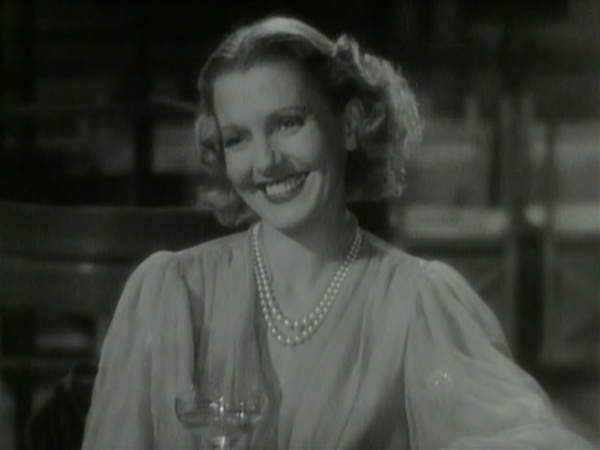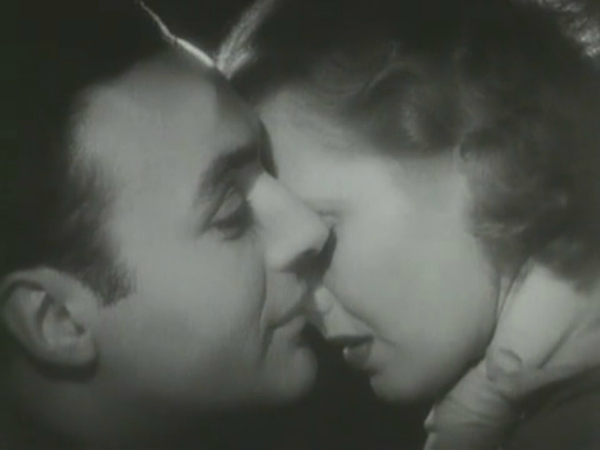
Coming down off of our months-long intensive on Japanese master melodramatist Mikio Naruse, I figured I’d find refuge in those most welcoming of arms – Hollywood product of the 1930s! I’ve said before that, although very few of my favorite films come from this era, I’d sooner watch a Hollywood film from the 30s than a film from anywhere else of any era. In spite of the whole Great Depression thing happening around them, these films displayed an inherent optimism, romanticism, showmanship, and buoyant belief in the human spirit that is, as far as I can tell, unmatched throughout cinematic history. And given that I’d been hitting up scattered shows in UCLA’s Jean Arthur retrospective, 1937’s Arthur-starring, Borzage-directed HIstory is Made at Night seemed right up my alley.
And indeed it was. Much like one could say Ingrid Bergman was the most vulnerable of classic screen stars, or Claudette Colbert the most alluring, Jean Arthur was the most generous. She was always not just immensely giving of herself, but equally understanding of whoever she shared the screen with. She radiated kindness, warmth, gentleness, and understanding, so that even when she was the one in peril, she didn’t let it show to those it didn’t concern.

In this film, for example, her character, Irene, is seeking a divorce after her insanely jealous husband, Bruce (Dr. Frankenstein himself, Colin Clive), accuses her of infidelity. How insanely jealous is this guy? Well, when he’s unable to produce evidence, he sends his chauffeur to her hotel room to make it appear as though they’ve had intimate relations, then sends a private detective in to get it on camera. Oh yeah, this guy is full-on nuts. What he didn’t account for is the man in the room next door interfering, staging a kidnapping, only to sweep Irene off her feet, giving her a taste of happiness, yes, but also confirming her husband’s worst suspicions.
While chiefly a melodrama (and more on that in a second), this being a 1930s film, it’s more than willing to have some fun along the way. The “kidnapper,” Paul Dumond (Charles Boyer), is the head waiter at one of the best restaurants in Paris, so he immediately takes her for a late-night meal and dance, convincing the chef and musicians to stay a little while longer. This is one of those grand, swooning sequences, slightly irreverent (Irene doesn’t realize her backhanded insult in ordering scrambled eggs from one of the top chefs in Paris, nor does she think twice about kicking off her heels when they give her trouble on the dance floor), but thoughtfully romantic.
But the husband interferes, as he always does, and uses all his clout as a ship owner (quite a racket in those days) to force Irene to stay with him. The whole thing is quite a lot of fun and heartache, but I want to throw in a spoiler warning here and discuss the ending, which I’m sure will turn off a great many people with its rather overt melodramatic machinations, but which I’d say is so informative of its time and more optimistic of its characters than a more “grounded” climax.

Eventually, Paul and Irene find a way to be together again, and are sailing to Paris on, ironically, a ship Irene’s husband built for her that bears her name. The problem, of course, is that as the ship’s owner, Bruce can pretty much do as he sees fit, and conveys orders via radio for the ship’s captain to go full speed ahead, knowing the fog and icy waters will eventually cause the ship to crash, killing all aboard. Inevitably, the ship does crash, and Irene chooses not to go with the women and children on the life boats, and stays with Paul. Certain of their impending doom, they hold each other, wishing they’d met earlier, had more time, but enjoying what little they have left together.
Until the crew announces they’ve managed to keep the ship afloat indefinitely and that help is on the way. Happy ending.
Now I know. That seems absurdly cheesy, grandiose in the worst ways, and totally divorced of the actual drama at hand. AND YET…I would actually argue this expands the film’s scope with a rather touching message ready-made for Depression-era audiences.
For starters, it reveals the priorities of the era – modern romance stories are (overly) obsessed with people “finding their soul mate” and “not settling” and it’s all very insular and selfish. Irene and Paul get along fabulously, and decide to be together. It’s as simple as that. The film is saying that the only thing that should get in the way of something as simple and delightful as romance is a giant iceberg.
Second – and this is the biggie – is that this is a great blow against the wealthy. Bruce may have the money and the power, but the working class built his ship sturdy enough to withstand a collision, and the working class are the ones who successfully keep it afloat. What more essential message could there be, not just for the Depression, but for societies of any era? It shows that even though the ruling class may use the workers as their pawns, and their livelihoods as their toys, the workers will endure.
Presented in SD on Criterion’s Hulu channel, I’m not going to lie, History is Made at Night looks rough. Not great. A bad print and a compressed transfer, with a little green in it to boot. You take what you can get, though, and this is hardly the worst condition I’ve seen a film in on Hulu, and it’s far from unwatchable. Just keep your eyes on ol’ Jean Arthur, she’ll carry you to safety.
I don’t know that there’s much here for a full-on Blu-ray release from Criterion; it wouldn’t overtly benefit from an HD transfer (though all films do at least a little bit), and it’s not a neglected classic like Make Way for Tomorrow. But there is so much thematic heft that one could dive into in supplements, never mind a short piece on the sinking of the Titanic, which happened only twenty-five years before this film was released and very obviously influenced the texture of the similar sequence in this film.
To try Hulu Plus and get two weeks free, click here.



![Bergman Island (The Criterion Collection) [Blu-ray]](https://criterioncast.com/wp-content/uploads/2022/11/bergman-island-the-criterion-collection-blu-ray-400x496.jpg)
![This Is Not a Burial, It’s a Resurrection (The Criterion Collection) [Blu-ray]](https://criterioncast.com/wp-content/uploads/2022/11/this-is-not-a-burial-its-a-resurrection-the-criterion-collection-blu-ray-400x496.jpg)
![Lars von Trier's Europe Trilogy (The Criterion Collection) [The Element of Crime/Epidemic/Europa] [Blu-ray]](https://criterioncast.com/wp-content/uploads/2022/11/lars-von-triers-europe-trilogy-the-criterion-collection-the-element-of-400x496.jpg)
![Imitation of Life (The Criterion Collection) [Blu-ray]](https://criterioncast.com/wp-content/uploads/2022/11/imitation-of-life-the-criterion-collection-blu-ray-400x496.jpg)
![The Adventures of Baron Munchausen (The Criterion Collection) [4K UHD]](https://criterioncast.com/wp-content/uploads/2022/11/the-adventures-of-baron-munchausen-the-criterion-collection-4k-uhd-400x496.jpg)
![Cooley High [Criterion Collection] [Blu-ray] [1975]](https://criterioncast.com/wp-content/uploads/2022/11/cooley-high-criterion-collection-blu-ray-1975-400x496.jpg)